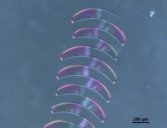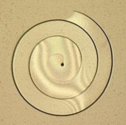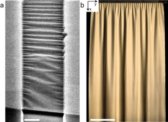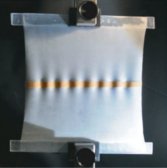Self-replicating cracks
[\
 Thin films are ubiquitous in engineering applications ranging from protective paints for our homes to the optical layers deposited on our glasses. However, coating processes generally result into residual strains and may induce the propagation straight cracks, eventually leading to the familiar patterns seen on dried mud or crockery glaze./]
Thin films are ubiquitous in engineering applications ranging from protective paints for our homes to the optical layers deposited on our glasses. However, coating processes generally result into residual strains and may induce the propagation straight cracks, eventually leading to the familiar patterns seen on dried mud or crockery glaze./]
We find that cracks can propagate in films considered as stable using standard engineering criteria, and form extremely regular patterns. Indeed, they follow intriguing paths such as Archimedean spirals, oscillating alleys or parallel stripes. A new fracture mechanism based on a coupling between delamination and crack propagation leads to the self-replication of an initial pattern. This mechanism selects a regular length scale of about 30 times the thickness, but independent from material properties.

The robustness of the peeled pattern may turn fracture into a designing tool for producing nano-objects. Beyond micro-technology, a curious observer can hunt for traces of these amazing patterns in painted walls... or even in the bark of trees!
- J. Marthelot, B. Roman, J. Bico, J. Teisseire, D. Dalmas & F. Melo, "Self-Replicating Cracks: A Collaborative Fracture Mode in Thin Films", Phys. Rev. Lett, 113, 85502 (2014).
Wrinkled curtains
[
 Have you ever payed attention to the wrinkles formed in a suspended curtain? The stitches usually induce relatively regular wrinkles. The number of wrinkles decreases progressively along the curtain.
Have you ever payed attention to the wrinkles formed in a suspended curtain? The stitches usually induce relatively regular wrinkles. The number of wrinkles decreases progressively along the curtain.
Similar wrinkles are also observed at the minute scale of graphene films suspended over a grove.
The evolution of the number of wrinkles follows intuition. Indeed a wrinkles propagating through the whole length of the curtain would generate a high elastic bending energy. Merging wrinkles progressively decreases this energy but nevertheless requires some stretching of the curtain. /]
- H. Vandeparre, M. Piñeirua, F. Brau, B. Roman, J. Bico, C. Gay, W. Bao, C.N. Lau, P.M. Reis & Pascal Damman, "Wrinkling Hierarchy in Constrained Thin Sheets from Suspended Graphene to Curtains", Phys. Rev. Lett., 106 224301 (2011)
Oscillatory fracture paths in thin elastic sheets
 We report a novel mode of oscillatory crack propagation when a cutting tip is driven through a thin brittle film. Experiments show that the amplitude and wavelength of the oscillatory crack paths scale linearly with the width of the cutting tip over a wide range of length-scales but are independent of the width of the sheet and of the cutting speed. A geometric model is presented, which provides a simple but thorough interpretation of the oscillations.
We report a novel mode of oscillatory crack propagation when a cutting tip is driven through a thin brittle film. Experiments show that the amplitude and wavelength of the oscillatory crack paths scale linearly with the width of the cutting tip over a wide range of length-scales but are independent of the width of the sheet and of the cutting speed. A geometric model is presented, which provides a simple but thorough interpretation of the oscillations.
Scars

[ Stretching an elastic sheet between a pair of opposite clamps induces a contraction through Poisson effect. While the stretching remains low out-of-plane deformations are not observed. Wrinkles however appear if the sheet is reinforced. Such morphology is also observed along scars on the skin.
In the case of the reinforcement by a fiber, we observe a transition to in-plane deformation of the fiber /]
- A. Takei, F. Brau, B. Roman & J. Bico, "Stretch-induced wrinkles in reinforced membranes: From out-of-plane to in-plane structures", EPL, 96, 64001 (2011)


